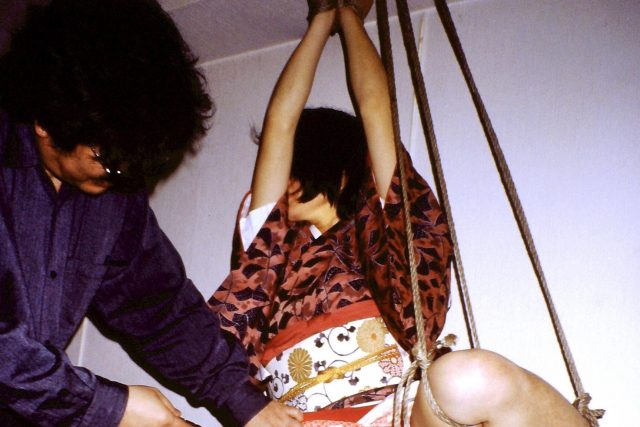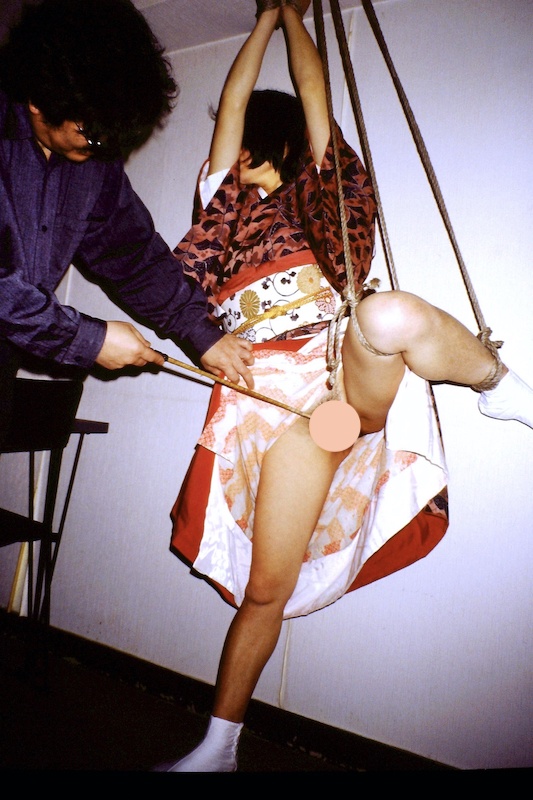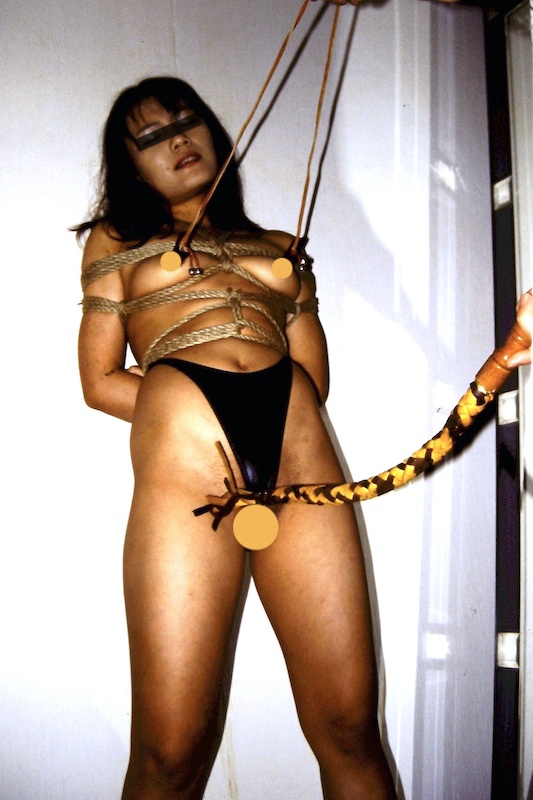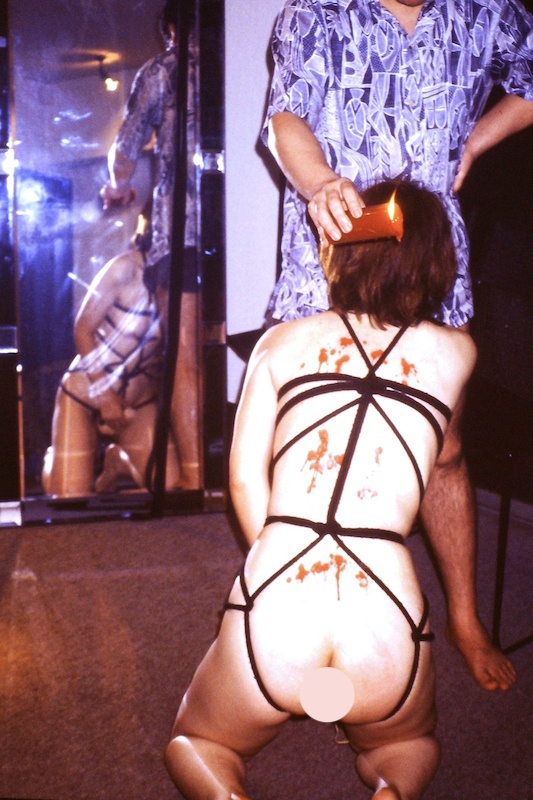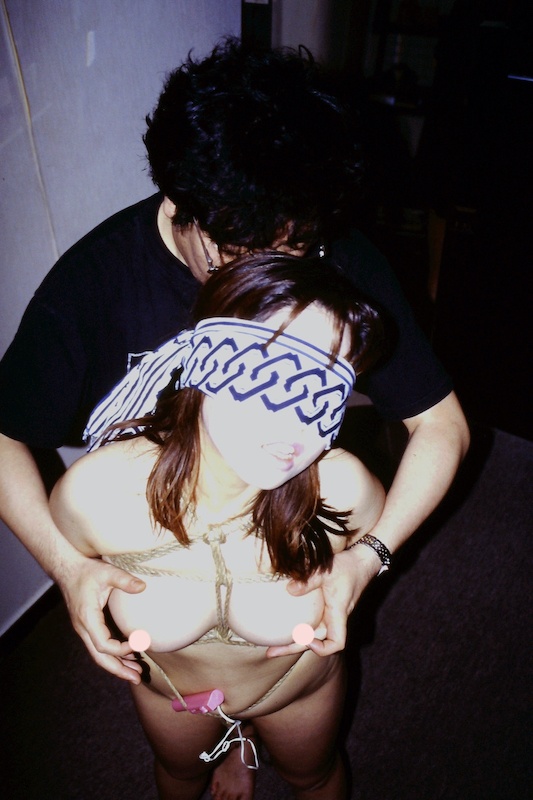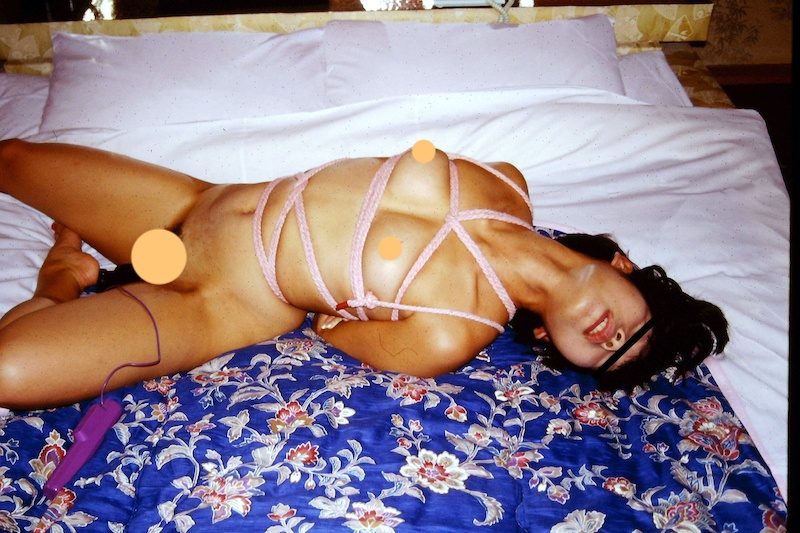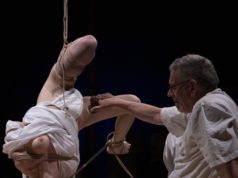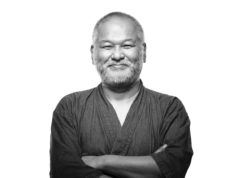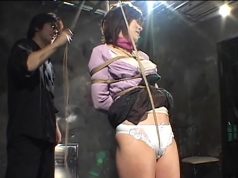From September 1979 until January 2009 S & M Sniper was a Japanese erotic magazine catering for sadomasochism and rope bondage. Unlike previous publications, the editor was responsible for the bondage without using a professional Kinbakushi. By using specialised makeup and costumes, rare for SM magazines until then, S & M Sniper succeeded in offering its readership fresh stimulation, and went on to create a new benchmark.
S & M Sniper magazine featured many now well established names of the rope bondage world, including Shikou Shima, Yukimura Haruki and Chiba Eizo, photographer Araki Nobuyoshi, writer Tetsuo Amano, manga artist Hiraguchi Hiromi, female Kinbakushi and mistress Seki Kazuko, one time Mama of the famous Nakano Queen SM club, Kayama Shigeru the owner of SM bar SAMM and the SAMM Video Company, and models such as Saotome Hiromi.
Hayakawa Yoshikazu was its resident Editor–in–Chief between May 1980 and June 1982, being the house Kinbakushi for many photoshoots. He was promoted to director of the editorial office of Million Publishing, and a year later went self–employed as a free editor.
Later, Hayakawa san, affectionately known as Hige would go on to open his members only SM salon, and then reluctantly branch into the new digital markets. I caught up with him at the Hige Salon, assisted with questioning by Ugo san of SMpedia.com, and with Yuki Sakurai making the final translations.
We began by clarifying the nickname Hige.
Hige: “There are three kinds. One is Kuchi Hige for moustache, and the other is Ago Hige for beard. The kanji is different. My name also means beard, like whiskers. Sometimes when Japanese people do bad things, they apologise and might have their head shaved. In my case, I shaved my beard.”
To be precise, the images presented of Hige san tying in issues of S & M Sniper depict a Hispanic horseshoe, like a Mexican bandito.
Hige: “I gave myself the nickname. There weren’t so many bearded people at the time, even in the editing world. Especially SM related editors were clean shaven. However, I was the chief editor of the previous company, Takeshobo, when I was only 28. I was really thin and a beautiful boy (laughs), so I was not dignified. I started growing my beard and kept it when I moved to Million. People started to call me Hige san.”
The eldest son of a kimono shop established by his grandparents in Koufu, the prefectural capital of Yamanashi–ken, and expected to inherent and take over the business, Hige san explained his formative years and his route into SM and rope bondage.
Hige: “Of course, I was expected to take over the business. What happened had a lot to do with why I got into the SM world. In a kimono shop one puts on and takes off clothes, and binds a woman (or a man) with Shigoki (志古貴), a decoration wrapped under an obi. Basically, we had to take off her clothes, put on a kimono and tie it, depending on the season, maybe three or four times. There are two types of business in a traditional kimono shop: a business at the storefront and a business at the back of the store. For example, we might present a set of wedding costumes at the back, and then let her try many different patterns. The same was true for important customers.
Therefore, as a young boy Hige san saw many people undressed and redressed with bindings over and over again.
Hige: “From such a point of view, tying was imprinted from my childhood as a familiar thing and also as a thing of beauty. And yes, it is erotic.”
He explained how he would go on to be a rebellious youth involved with anti–establishment politics, e.g. the anti–Vietnam War and the student union movements.
Hige: “With that kind of background and wealthy home environment, I was expected to go to university because I was the eldest son. A student of Yamanashi University became a tutor when I was ten years old. The tutor was a student movement activist of the 1960s and taught me about politics and rebellion. There my anti–war and anti–establishment spirit evolved. I really admired the tutor. He also taught me about mystery novels, introducing me to characters such as Arsène Lupine and Sherlock Holmes.
Then I accidentally saw a love affair between the tutor and my mother. I was almost 11 years old. Both my study room and bedroom were on the second floor, and my tutor came to my study room to teach me. When we finished studying, I went to the first floor to watch TV and my mother came to the study room to give him a cup of tea and sweets. One day I went to the second floor for some reason, and saw my mother kissing my tutor. My mother mostly wore kimonos, so she was wearing one at that time, holding her hands on his neck and putting their mouths together. I was surprised and thought that I mustn’t see this, so I rushed back to the first floor.
As a moralistic child, I should have told my father about it. But I didn’t. I couldn’t. This made me feel that I shouldn’t stay because I felt I had betrayed the honour of the house by my observation and silence. When I was 12 years old, I told my 10–year old brother that I was planning to leave and let him inherit the family estate. I didn’t have any dissatisfaction with my wealthy home, but the rebellion in me came from the influence of the tutor, who I continued to respect. It was a kind of pandemic at the time. Of course, I read Marx and Lenin afterwards, but after all, it’s not that kind of principle (communism), I just wanted to change the existing system. I still have contact to my brother, and he occasionally visits my salon for a drink.”
So, did Hige san think that the student anti–establishment movement was related to sexual freedom and SM at the time.
Hige: “I would agree. There was definitely dissident. But with me, it was rather the thing with my mother.”
Or, did he get involved with SM with the consciousness of punishing women?
Hige: “It’s not just loving, but binding the woman to make her my own. And it is also a kind of punishment for my mother which I actually couldn’t do (to her). Something like smacking a woman’s bottom as a punishment for doing dirty things. I think I am a feminist, but I’m also a kind of sadist in a sexual manner. But when I see photos of western sadists, I feel they are different from my world. But then, I wouldn’t consider myself normal.
Basically, I couldn’t forgive my mother for witnessing her affair. That’s why I left home. But my mother was also a good person, and I still respected her. My father was also a good person. He was fine in society, but a bit sloppy as a man who had to protect his house as the second generation. Rather than choosing one or the other, I thought I had to leave to protect the honour of our house.”
In his blog, Hige san had stated how he was influenced by the erotic literature of Shimizu, and an entertaining account of, for example, as a pubescent, training his penis through masturbation, witnessing sex for the first time through the window of a brothel, and losing his virginity at a love hotel in a red light district – a special kind of sexual education. He was asked if he believed these events were the beginning of his journey into the world of erotic publishing?
Hige: “When I was in elementary school, I had many dreams. I wanted to be a lawyer. I also wanted to get involved in publishing because I liked books. I didn’t think I could actually do so. Then I entered Senshu University which was very traditional, but that was not where I wanted to go. In addition, I was in a second graduating class in junior high and high school because I am from the baby boomer generation. So, there was no history and no customs, and we were free to create our own school rules. However, Senshu University is almost a hundred years old.
I belonged to an organization of student movements and went on demonstrations, which was quite dangerous. The tactics gradually escalated around six months after I started. But I didn’t agree with using violence because I did not want to kill people or to be hurt myself. Also, while advocating against the Vietnam war, the movement divided more and more. I couldn’t do it anymore, and left the movement.
At that time, my friend who was a Wako University student told me that it was a very progressive and interesting school. So, we went to the school together, and I was told to meet the President and talk directly. The president actually met us and listened to our stories. I decided to quit Senshu University and entered Wako University.”
By 18 he was having many sexual encounters, and began cultivating a perspective of desiring how to fully pleasure a woman, rather than just taking what most young men wanted, sexually. He sought to learn their bodies, their reactions, their pleasures. After transferring universities from learning law to human studies, and his political activism ended, we asked if he believed his increasing knowledge of satisfying a woman was a help and an encouragement to his interest in SM.
Hige: “Well, yes, of course.”
During his time at Wako University, he worked as a part–time waiter in a Spanish Flamenco bar in Shinjuku.
Hige: “When I entered Wako University, the first year was with ordinary classes. However, the school became barricaded during the second year. Since I was an activist, I had many friends in the student movement. I was living near the university, so every student activist came to my place. Without talking about politics, we played mahjong and sometimes I served them a meal.
I was renting a room in an apartment building. My girlfriend lived in the room opposite, so we were almost cohabiting. Our parents knew it, and said that we may marry when we graduate university.
We went to a bar together where they performed Flamenco shows. I really loved Flamenco since I saw Francisco Rovira Beleta’s film Los Tarantos when I was in the first grade of junior high school. Young people like myself and my girlfriend rarely went to such a bar, so the waiters and the owner asked us the reason we came. Then the owner asked me if I could work part–time, and I decided to do it. Because it was a luxury bar, it was a good salary and also great tips. At that time, a typical salary would be about ¥20,000 ($55 in 1970) a month, and you’d get tips of about ¥1,000. But at this type of bar the salary was about the same, but the tip was more than ¥20,000. One day a waiter retired, so my girlfriend became a waitress. Then the boss retired and we started to manage the bar together.
I didn’t mean to find a job. It just happened. I continued the work there for nearly two years. However, the proprietor of the bar died in a car accident and the bar had to close. I was also informed that the university had stopped being barricaded and would return to regular classes in April. I didn’t think I had enough credits to graduate, so even if I went back to class every day, it would impossible to get enough credits in a year. So, I began to think about any employment I could get without graduating from university.
I remembered Spanish Flamenco dancers saying they got stiff shoulders and legs. My massage skills were pretty good because I’d been doing massages for my parents since I was a child. So, I planned to train in a Japanese massage shop for about a year and then go to Spain to make a living by massaging Flamenco dancers. My plan was that after experiencing Spanish culture and the people, I could come back to Japan, write the texts, become a reporter, and then become an editor. I would then be about 22 years old. I yearned for Spain, because I was learning about Flamenco. But I never did manage to go.
In the December of my fourth year at Wako University I prepared myself that I wouldn’t be able to get a job. So, I was apprenticed by a doctor of osteopathic medicine who knew my family very well. I took it very seriously. I would wake up at 05:00, wash, prepare a meal, and spend most of my time on my feet getting to work by 09:00. I got used to it for about a month and a half. I returned to Tokyo to quit my boarding house, and then went to the university to say hello to my professor. He told me I could graduate.”
And this becomes the catalyst moment to propel Hige san into erotic publishing.
Hige: “I first read Misaki Shobo’s Erotica when I was in the second year at university. It was not a porn magazine, but contained eroticism for cultural anthropology and sociology. I dreamt about being an editor for Misaki Shobo. So, I decided to call them, and was able to talk directly to the president. Everything went well very quickly and I was hired straight away.
About half a year before I could start working, Erotica #29 and #31 had been banned. Munehiro Hayashi, the President had graduated from the Faculty of Law at Kyoto University. He liked to challenge the authorities and make them nervous. I didn’t like that sort of conflict, but then, I wouldn’t have been hired if it wasn’t for such a character running the publishing company. I started working in sales, but Misaki Shobo is where I gained my basic training in editorial, publishing and circulation.”
We then asked Hige san about the period working for Misaki Shobo and before joining Million Publishing.
Hige: “I was Chief Editor of Genso to Kaiki (Fantasy & Mystery) for its first edition when Misaki Shobo went bankrupt in 1973. The magazine continued until #12 with the mother company, Saigetsu–sha, and I continued editing it with them until #11.
Koaku Yukio was the illustrator of the fantasy pictures. I didn’t think that we got along. But he contacted Tsukasa Syobō and suggested I go there.”
Tsukasa Syobō was founded in 1971 as an affiliate company of Touen Syobō, which was founded around 1948.
Hige: “Touen Syobō was publishing a non–erotic story magazine called Novel Club at that time. I was supposed to go Touen Syobō. But actually, I went to its daughter company Tsukasa Syobō, which was publishing erotic magazines such as SM Fan and Bessatsu (Extra volume) SM Fan. I got an offer to work for these.
I wasn’t shocked, because I was secretly indulging in SM practices. I’d read Kitan Club with my girlfriend since I was in the second year at University. But I never thought I was going to get a job in such a place. With Genso to Kaiki I thought that I was going to make a novel magazine. Why on earth should I edit an SM magazine? Nobody knew I was enjoying SM at that time. I didn’t tell anybody. You didn’t back then. Maybe Koaku san suspected, and of course, I knew SM Fan magazine.”
Elaborating on his time entering the world of SM publishing, we asked Hige san to explain those days with SM Fan, his seemingly in–out relationship with S & M Sniper, and Japanese society’s then attitude that sadomasochism was tantamount to a criminal act.
Hige: “My problem is that when I do something for long enough, I get tired and want to move on and do something different. Sadomasochism at that time during the late 70s was the world of only right and wrong. The authorities did not permit us to publish without moral objection. In short, people who played SM were considered bad people who abducted girls. If a woman liked it, the Police or a close relative would intervene and do their best to stop it. I really hated such stories. Additionally, editors had to cut material because censorship was so severe. At that time, Manga began to come into style. Tsukasa Syobō was recruiting so I went to have an interview. I went on to work for SM Fan for about two and a half years.
The president of Million Publishing at that time had originally come from Tsukasa Syobō. Hirata san was one year older than me. He, Masashi Sudo, the first editor of S & M Sniper and I used to play mahjong together. At that time, about 10 kinds of SM magazine were being published, so Million Publishing wanted to get in on the act and also publish one. However, all SM writers were writing anonymously back then, so Sudo couldn’t find any. I introduced some I knew to him, and also gave my advice about what should be in an SM magazine. After 3 months Sudo went missing due to various things. Then Tsukasa Syobō bounced a paycheck on me. So, after I settled that, I opted to make a career move to Million to edit S & M Sniper magazine.
But then they wanted me to also edit a second magazine, SM Novel Sniper, and I wanted my salary doubled. It was imposed on me. We had to publish both magazines with 5 people, including 2 who had just graduated from university. It was really extraordinary work.
Million Publishing was owned by Taiyo Tosho, a powerful publishing agent/publisher. That’s why there is a Taiyo Tosho group holding apart from the Tsukasa Syobō and Touen Syobō group. Now Sanwa is also part of the Taiyo Tosho group. Million’s president decided to launch S & M Sniper, and Taiyo Tosho agreed with it, leaving it to him to manage and organize.”
With so much detail presented relating to his professional life, how was Hige san’s private erotic life developing as he had become an experienced adult?
Hige: “Before I got involved with the Sniper magazines, I only played SM with my lovers. I got married, but at most, only tied and played with three partners. After I got involved with Sniper, many masochistic girls would come to meet me. Because I also regularly wrote for Sniper as a freelance writer, and not as an editor, they thought that there was actually such a character.
I went back to Tsukasa Shiyobō for about two years on a commission basis. I had worked for S & M Sniper for three and a half years and started to hate being involved with Million Publishing.
On a commission, I was a man for all kinds of work. I thought that the feature Hige no Kouyuuroku (Hige’s friendship and play) would be discontinued if I left Million. But they asked me to continue it because it was still very popular.
When I was writing as the pseudonym Yumemura, I wasn’t actually indulging in much SM. I just made up stories with images and text, and wrote down how Yumemura would have reacted. In reality, I had two slaves at that time, but wasn’t playing other than with them.
Plastic covered Bini hon magazines were just beginning to appear at that time (to cover content so that Sukebe – lecherous men could not finger through and/or damage the pages without purchasing). So, the Sniper magazines were still a medium that women could easily get access to. High school girls would read them and I’d receive fan letters. Everyone was so hungry for information. Girls would think that they may probably be masochistic, but couldn’t say it to anyone for a long time. That’s why they made inquiring phone calls to me. And at last, I could play with these people.”
Ugo: “My girlfriend was also a regular reader of S & M Sniper.”
Hige: “Oh, really? (laughs)”
By the late 1990s the world was changing with the digital revolution, and Hige san, recognizing the shift in media followed suit.
Hige: “I was very late to get involved with the Internet. People around me told me that I had to do it. I started doing it, but I wasn’t prepared for it.
I started Hige Salon on the Internet. It still remains, because it is free. I just put there what I wrote. It’s almost a voluntary activity. I never earned any money from it (laughs).”
In 2001 he established SM lounge MUGEN in Roppongi at roughly the same time others (e.g. Hishishi Oda’s Jail) were opening. We asked if this expansion and diversification was as a result of market demand for SM related venues to visit. Was it a generational change in consumer attitudes, and why was the market for SM expanding and becoming more open?
Hige: “It was an era when Internet communication was becoming more and more successful. Hige Salon was for couples only. I then thought people might want a place where they can come alone and feel the atmosphere of and talk about SM. So, I decided to open such a place. We already had a day for single men in Hige Salon. I was worried that a lot of weird people might come, or we’d get nuisance phone calls. But such things rarely happened. I heard some people got their blogs flamed, but not mine. Maybe I was ignored (laughs). No cheering, but no slander (laughs).“
So how did he get to know celebrities such as Matsui Kenji and Akechi Denki?
Hige: “Matsui san came to Hige Salon as a guest. He wasn’t teaching rope at that time, but just a practitioner, a devotee of SM. He was sticking to Kinbaku. Chibi chan was a famous partner of Matsui san, but he was with a tall and slender girl named Yoshiko when he came to Hige Salon. She worked as a secretary in his professional office.
I found an old cassette tape which was recorded in the 80s of a threesome with Matsui san, his young slave Yoshiko, and a mistress who was then working at Nakano Queen. The sound quality is poor because it is very old.
Matsui san and I had a long relationship, but I didn’t go to his place. Instead, he sometimes came to my place, tied his partner and showed it to audiences.
Akechi san and Matsui san never came together. I never charged Akechi san because he was a guest of Hige Salon.
I played SM along with Matsui san in private, but I never had such a chance with Akechi san.”
Hige san revived Hige Salon at Snack Nakamura in 2006. We asked what his motivation was, and why it closed 3 years later.
Hige: “That’s simple. I closed MUGEN because I could not keep it anymore. People who used to go Hige Salon or MUGEN had no place to go and asked me to make another place for them. So, I rented a part of Mistress Akemi’s dominatrix lounge Snack Nakamura in Shinjuku and continued Hige Salon.
Now Hige Salon had booths, and was open from 6 to 11pm. However, because most of us were not so young anymore to be able to drink until late, we usually closed at 10. Opening the place just for 4 hours was hard work, so we closed 3 years later. Then a customer, Hiro san rented his place in Shinjuku–Gyoen, so we did it again for another 3 years until 2012.”
Hige san revived his salon in early 2019. We asked what his hopes were, what he expected his client base to be, what the philosophy was, and if it’s a place that would welcome foreigners.
Hige: “We welcome everyone. People come here to enjoy participating in conversation about SM. I wonder if Gaijin can be really satisfied if they cannot join in discussions. But, if they can overcome the language barrier, we always welcome everyone.
I left the SM world for about 7 years, but I heard that people want to go Hige Salon again, so I started it once a month. I don’t really have an idea of providing a message, or doing something bigger in the future.”
With enthusiasm for rope bondage growing so rapidly outside of Japan, we asked how he felt about this rise in interest, and how magazines such as S & M Sniper have become collector items around the world.
Hige: “I am not a Kinbakushi, and I don’t want people to think that I’m one. Japanese Kinbaku had been developing as a performance show in strip theaters. The Shibari evolved in such places, but it became really stressful for the human body in order to make it look more gorgeous. The reason of the difference is because I, either Yumemura or Hige, am dealing with amateur ladies. Some scars or blood may be acceptable in a performance show. However, I have to leave no trace on the lady’s body.”
It was noted how Social Media has had such an effect on the purveyance of SM, erotica and rope bondage around the world. How it significantly changed perceptions, from minimal available providers (e.g. models, artists, writers, Kinbakushi, etc.), consumption being largely hidden, absorbed in secret, and practiced less, to the current huge surge in participation, sharing images, etc. of what would previously have been kept very secret, underground.
We asked, as a former editor of sadomasochistic rope bondage publications, how Hige san felt about this change, and how he felt it may have affected the erotic publishing industry.
Hige: “I agree. It has changed. Real SM is very sober and not gorgeous. My play has erotic shame, and very subtle context like taking off her clothing, one by one. But such feelings may be lost. So, I think that my days are over.”
Ugo: “I agree with Sin san, that SM fans used to be consumers and they did not participate. However, everyone wants to tie nowadays. With people changing to participate, the focus of attention is no longer the model, but the one tying and how they tie.”
Hige: “As you can see from published series where I am tying, my face is barely visible. Other people now want to be the focus of attention. But I make the beauty of the ladies that focal attention. In my SM, a lady’s facial expression, body posture, and her appearance change little by little over time.”
Ugo: “Maybe that is individuality rather than change over time.”
Hige: “Yes, exactly. In the end, I do what I am satisfied with and my pursuit of satisfaction is SM and eroticism. So, I understand that each SM differs from another.”
Ugo: “I think that people who make an impression like Akechi san and Nureki san are that sort of person. They always think about how to please the ladies first.”
Finally, we asked if Hige san had any plans and hopes for the future.
Hige: “Nothing (laughs). As I said before, I don’t know when people might abandon my monthly salon. I always welcome the old customers, but I guess it’s a big deal for young people to find out about this place, and a completely new customer rarely comes. Most people already know me even though they may come for the first time. Sometimes the male guests may bring new ladies, but the men are mostly established MUGEN or Hige Salon customers. Some have been coming for over 20 years.
We cannot publish SM magazines anymore because there are no book stores. We cannot sell paper–based media without books stores, especially these kinds of pornographic books. Since there are no sales channels, at best it will all go to the Internet. Adult videos are also difficult to sell.”
Was it possible that the anti-digital movement among young people who prefer e.g. vinyl records and printed books, etc., if the articles were translated into multiple languages, like they used to do in the 70s and 80s with Scandinavian magazines might change that?
Hige: “Especially for Japanese articles? It depends on how many people want it globally. It is not easy because national character differs by country. In Japan we have erotic shame (羞恥 – Shuuchi), but I don’t see it existing so much in foreign countries. Also, the relationships between a master and a slave differs. It seems to be more contractual in foreign countries, and very lyrical in Japan.
Ugo: “The first thing that surprised me when I started to socialise with foreign people was that they do not feel ashamed or embarrassed (恥ずかしい Hazukashii) in the same ways. They don‘t really have such feelings. And now, even young Japanese girls are also losing such feelings. So, I think the old Japanese SM will be lost in future. In 30 or 40 years from now, such Hazukashii feelings will probably also be lost in Japan.”
Hige: “Can foreign people enjoy erotic shame? Basically, no. As far as I can see in foreign Victorian pornography, they are not what we think of as erotic shame. In the case of a noble princess who wants to protect her purity, she feels humiliation, but not erotic shame.”
Ugo: “I think they did have erotic shame in SM in the early days of Victorian porn.”
Hige: “Maybe a very small part of them.”
Ugo: “Getting red in the face (blushing with erotic shame) is not good in the West now, but it was good in the past. Maybe because blushing unnecessarily means that the person is considered weak as a human. But formerly there was a time when ladies blushing was considered beautiful. A foreign person told me that their grandmother used to say this. So, I think erotic shame existed in older times, but it’s being rapidly lost. Such feelings will change depending on the times.”
Hige: “I couldn’t tell anyone that I was doing SM. I kept is a closely guarded secret that I was kinky, and I played SM with people who I really loved. The same goes for ladies, of course. Ladies played SM with me, but they feigned a look of innocence when they got home. It was such an era.”
Sin: “I kind of miss those days.”
Ugo: “But S & M Sniper captured it.”
Hige laughs.

